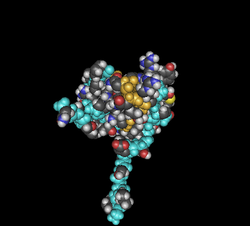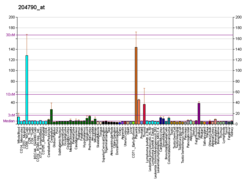「SMAD7」の版間の差分
Smilesworth (会話 | 投稿記録) en:Mothers against decapentaplegic homolog 7 (04:18, 25 March 2024 UTC) の翻訳をもとに作成 |
(相違点なし)
|
2024年4月26日 (金) 14:52時点における版
SMAD7(SMAD family member 7)は、ヒトではSMAD7遺伝子にコードされるタンパク質である[5]。
構造
Smadタンパク質には2つの保存されたドメイン、N末端のMH1(Mad homology 1)ドメインとC末端のMH2(Mad homology 2)ドメインが存在する。両者の間にはリンカー領域が存在し、そこには多くの調節部位が位置している。MH1ドメインはDNA結合活性を有するのに対し、MH2ドメインは転写活性化能を有する[6]。リンカー領域には、MAPK[7]やCaMKII[8]、PKC[9]によるリン酸化部位など、重要な調節モチーフが含まれている。SMAD7にはMH1ドメインは存在せず、リンカー領域に存在するプロリン-チロシン(PY)モチーフはE3ユビキチンリガーゼであるSMURF2のWWドメインとの相互作用を可能にしている。SMAD7は基底状態では主に核内に位置し、TGF-β刺激に伴って細胞質へ移行する[10]。
機能
SMAD7は、TGF-βシグナルの伝達を開始するSMAD2/SMAD4複合体の形成を妨げることで、シグナル伝達を阻害する。SMAD7は活性化されたTGF-β I型受容体と相互作用し、SMAD2の結合、リン酸化そして活性化を遮断する[11]。また、アクチビンやBMPに対するI型受容体にも結合し、これらの経路においてもネガティブフィードバックとしての機能を果たしている[12][13]。
TGF-β処理に伴って、SMAD7はMH2ドメインを介してPellino-1へ結合する。この相互作用はIRAK1を介したIL-1R/TLRシグナル伝達複合体の形成を遮断してNF-κB活性を抑制し、炎症促進遺伝子の発現の低下を引き起こす[14]。
SMAD7はTGF-βによって誘導されるが、EGF、IFN-γ、TNF-αなど他の刺激によっても誘導される。そのため、SMAD7はTGF-βシグナルとその他のシグナル伝達経路の間のクロストークをもたらす[15]。
がんにおける役割
SMAD7遺伝子の変異は大腸がんの感受性の原因となる[16]。大腸がんではSMAD7のアップレギュレーションとTGF-βシグナルの抑制が生じている[17]。アジア・ヨーロッパ集団を対象とした症例対照研究やメタアナリシスにおいても、SMAD7の変異と大腸がんリスクとの関連が示されている[18]。
TGF-βは膵がんにおける重要な成長因子の1つである。SMAD7はTGF-β経路を制御することで、この疾患と関係していると考えられている。膵がん細胞におけるSMAD7の過剰発現を示す研究も低発現を示す研究もあり、膵がんにおけるSMAD7の役割に関してはいまだ議論がある[19][20][21][22]。
上皮成長因子受容体(EGFR)の過剰発現または恒常的活性化は、腫瘍過程を促進する[23][24]。EGFによって誘導されるMMP-9の発現は、乳がんや卵巣がんなど一部の腫瘍細胞の浸潤と転移を促進する[25][26]。SMAD7はEGFシグナル伝達経路に対して阻害的効果を示すため、がんの転移の防止に関与している可能性がある[27]。
相互作用
SMAD7は次に挙げる因子と相互作用することが示されている。
- CTNNB1[28]
- EP300[29]
- TAB1[30][31]
- PIAS4[32]
- RNF111[33]
- SMAD3[34][35]
- SMAD6[36]
- SMURF2[37][38][39]
- STRAP[34]
- TGFBR1[11][33][34][37][38][40]
- YAP1[41]
出典
- ^ a b c GRCh38: Ensembl release 89: ENSG00000101665 - Ensembl, May 2017
- ^ a b c GRCm38: Ensembl release 89: ENSMUSG00000025880 - Ensembl, May 2017
- ^ Human PubMed Reference:
- ^ Mouse PubMed Reference:
- ^ “SMAD7 SMAD family member 7 [Homo sapiens (human) - Gene - NCBI]”. www.ncbi.nlm.nih.gov. 2024年4月23日閲覧。
- ^ “A structural basis for mutational inactivation of the tumour suppressor Smad4”. Nature 388 (6637): 87–93. (July 1997). Bibcode: 1997Natur.388R..87S. doi:10.1038/40431. PMID 9214508.
- ^ “Opposing BMP and EGF signalling pathways converge on the TGF-beta family mediator Smad1”. Nature 389 (6651): 618–22. (October 1997). Bibcode: 1997Natur.389..618K. doi:10.1038/39348. PMID 9335504.
- ^ “Inactivation of smad-transforming growth factor beta signaling by Ca(2+)-calmodulin-dependent protein kinase II”. Mol. Cell. Biol. 20 (21): 8103–11. (November 2000). doi:10.1128/MCB.20.21.8103-8111.2000. PMC 86420. PMID 11027280.
- ^ “Regulation of Smad signaling by protein kinase C”. FASEB J. 15 (3): 553–5. (March 2001). doi:10.1096/fj.00-0474fje. PMID 11259364.
- ^ “Transforming growth factor beta1 induces nuclear export of inhibitory Smad7”. J. Biol. Chem. 273 (44): 29195–201. (October 1998). doi:10.1074/jbc.273.44.29195. PMID 9786930.
- ^ a b “The MAD-related protein Smad7 associates with the TGFbeta receptor and functions as an antagonist of TGFbeta signaling”. Cell 89 (7): 1165–73. (June 1997). doi:10.1016/S0092-8674(00)80303-7. PMID 9215638.
- ^ “Differential inhibition of Smad6 and Smad7 on bone morphogenetic protein- and activin-mediated growth arrest and apoptosis in B cells”. J. Biol. Chem. 274 (19): 13637–42. (May 1999). doi:10.1074/jbc.274.19.13637. PMID 10224135.
- ^ “Identification of Smad7, a TGFbeta-inducible antagonist of TGF-β signalling”. Nature 389 (6651): 631–5. (October 1997). Bibcode: 1997Natur.389..631N. doi:10.1038/39369. PMID 9335507.
- ^ “Smad7 and Smad6 bind to discrete regions of Pellino-1 via their MH2 domains to mediate TGF-beta1-induced negative regulation of IL-1R/TLR signaling”. Biochem. Biophys. Res. Commun. 393 (4): 836–43. (March 2010). doi:10.1016/j.bbrc.2010.02.094. PMID 20171181.
- ^ “A mechanism of suppression of TGF-beta/SMAD signaling by NF-kappa B/RelA”. Genes Dev. 14 (2): 187–97. (January 2000). doi:10.1101/gad.14.2.187. PMC 316349. PMID 10652273.
- ^ “Entry - #612229 - COLORECTAL CANCER, SUSCEPTIBILITY TO, 3; CRCS3 - OMIM”. www.omim.org. 2024年4月26日閲覧。
- ^ “Smad7 induces hepatic metastasis in colorectal cancer”. Br. J. Cancer 99 (6): 957–65. (September 2008). doi:10.1038/sj.bjc.6604562. PMC 2538763. PMID 18781153.
- ^ Peterlongo, Paolo, ed (2012). “A common SMAD7 variant is associated with risk of colorectal cancer: evidence from a case-control study and a meta-analysis”. PLOS ONE 7 (3): e33318. Bibcode: 2012PLoSO...733318S. doi:10.1371/journal.pone.0033318. PMC 3310071. PMID 22457752.
- ^ “The Smad family and its role in pancreatic cancer”. Indian J Cancer 48 (3): 351–60. (2011). doi:10.4103/0019-509X.84939. PMID 21921337.
- ^ “The TGF-beta signaling inhibitor Smad7 enhances tumorigenicity in pancreatic cancer”. Oncogene 18 (39): 5363–72. (September 1999). doi:10.1038/sj.onc.1202909. PMID 10498890.
- ^ “Yes-associated protein (YAP65) in relation to Smad7 expression in human pancreatic ductal adenocarcinoma”. Int. J. Mol. Med. 17 (5): 761–7. (May 2006). doi:10.3892/ijmm.17.5.761. PMID 16596258.
- ^ “Thioredoxin is downstream of Smad7 in a pathway that promotes growth and suppresses cisplatin-induced apoptosis in pancreatic cancer”. Cancer Res. 64 (10): 3599–606. (May 2004). doi:10.1158/0008-5472.CAN-03-2999. PMID 15150118.
- ^ “Epidermal growth factor-related peptides and their receptors in human malignancies”. Crit. Rev. Oncol. Hematol. 19 (3): 183–232. (July 1995). doi:10.1016/1040-8428(94)00144-I. PMID 7612182.
- ^ “An open-and-shut case? Recent insights into the activation of EGF/ErbB receptors”. Mol. Cell 12 (3): 541–52. (September 2003). doi:10.1016/S1097-2765(03)00350-2. PMID 14527402.
- ^ “EGF-induced MMP-9 expression is mediated by the JAK3/ERK pathway, but not by the JAK3/STAT-3 pathway in a SKBR3 breast cancer cell line”. Cell. Signal. 21 (6): 892–8. (June 2009). doi:10.1016/j.cellsig.2009.01.034. PMID 19385051.
- ^ “Proteinase requirements of epidermal growth factor-induced ovarian cancer cell invasion”. Int. J. Cancer 78 (3): 331–7. (October 1998). doi:10.1002/(SICI)1097-0215(19981029)78:3<331::AID-IJC13>3.0.CO;2-9. PMID 9766568.
- ^ “Smad7 acts as a negative regulator of the epidermal growth factor (EGF) signaling pathway in breast cancer cells”. Cancer Lett. 314 (2): 147–54. (January 2012). doi:10.1016/j.canlet.2011.09.024. PMID 22033246.
- ^ “Interaction between Smad7 and beta-catenin: importance for transforming growth factor beta-induced apoptosis”. Mol. Cell. Biol. 25 (4): 1475–88. (February 2005). doi:10.1128/MCB.25.4.1475-1488.2005. PMC 548008. PMID 15684397.
- ^ “Control of Smad7 stability by competition between acetylation and ubiquitination”. Mol. Cell 10 (3): 483–93. (September 2002). doi:10.1016/S1097-2765(02)00639-1. PMID 12408818.
- ^ “Transforming growth factor-beta1 (TGF-beta)-induced apoptosis of prostate cancer cells involves Smad7-dependent activation of p38 by TGF-beta-activated kinase 1 and mitogen-activated protein kinase kinase 3”. Mol. Biol. Cell 14 (2): 529–44. (February 2003). doi:10.1091/mbc.02-03-0037. PMC 149990. PMID 12589052.
- ^ “Inhibition of BMP2-induced, TAK1 kinase-mediated neurite outgrowth by Smad6 and Smad7”. Genes Cells 6 (12): 1091–9. (December 2001). doi:10.1046/j.1365-2443.2001.00483.x. PMID 11737269.
- ^ “Regulation of transforming growth factor-beta signaling by protein inhibitor of activated STAT, PIASy through Smad3”. J. Biol. Chem. 278 (36): 34253–8. (September 2003). doi:10.1074/jbc.M304961200. hdl:2115/28123. PMID 12815042.
- ^ a b “Arkadia amplifies TGF-beta superfamily signalling through degradation of Smad7”. EMBO J. 22 (24): 6458–70. (December 2003). doi:10.1093/emboj/cdg632. PMC 291827. PMID 14657019.
- ^ a b c “STRAP and Smad7 synergize in the inhibition of transforming growth factor beta signaling”. Mol. Cell. Biol. 20 (9): 3157–67. (May 2000). doi:10.1128/MCB.20.9.3157-3167.2000. PMC 85610. PMID 10757800.
- ^ “Roles of pathway-specific and inhibitory Smads in activin receptor signaling”. Mol. Endocrinol. 13 (1): 15–23. (January 1999). doi:10.1210/mend.13.1.0218. PMID 9892009.
- ^ “Vascular MADs: two novel MAD-related genes selectively inducible by flow in human vascular endothelium”. Proc. Natl. Acad. Sci. U.S.A. 94 (17): 9314–9. (August 1997). Bibcode: 1997PNAS...94.9314T. doi:10.1073/pnas.94.17.9314. PMC 23174. PMID 9256479.
- ^ a b “Impaired Smad7-Smurf-mediated negative regulation of TGF-beta signaling in scleroderma fibroblasts”. J. Clin. Invest. 113 (2): 253–64. (January 2004). doi:10.1172/JCI16269. PMC 310747. PMID 14722617.
- ^ a b “Smad7 binds to Smurf2 to form an E3 ubiquitin ligase that targets the TGF beta receptor for degradation”. Mol. Cell 6 (6): 1365–75. (December 2000). doi:10.1016/S1097-2765(00)00134-9. PMID 11163210.
- ^ “AIMP1/p43 downregulates TGF-beta signaling via stabilization of smurf2”. Biochem. Biophys. Res. Commun. 371 (3): 395–400. (July 2008). doi:10.1016/j.bbrc.2008.04.099. PMID 18448069.
- ^ “Roles for the MH2 domain of Smad7 in the specific inhibition of transforming growth factor-beta superfamily signaling”. J. Biol. Chem. 279 (30): 31568–74. (July 2004). doi:10.1074/jbc.M313977200. PMID 15148321.
- ^ “Yes-associated protein (YAP65) interacts with Smad7 and potentiates its inhibitory activity against TGF-beta/Smad signaling”. Oncogene 21 (32): 4879–84. (July 2002). doi:10.1038/sj.onc.1205623. PMID 12118366.
関連文献
- “TGF-beta signal transduction”. Annu. Rev. Biochem. 67: 753–91. (1998). doi:10.1146/annurev.biochem.67.1.753. PMID 9759503.
- “Remarkable versatility of Smad proteins in the nucleus of transforming growth factor-beta activated cells”. Cytokine Growth Factor Rev. 10 (3–4): 187–99. (1999). doi:10.1016/S1359-6101(99)00012-X. PMID 10647776.
- “The Smad pathway”. Cytokine Growth Factor Rev. 11 (1–2): 5–13. (2000). doi:10.1016/S1359-6101(99)00024-6. PMID 10708948.
- “TGF-β signaling by Smad proteins”. Advances in Immunology Volume 75. 75. (2000). pp. 115–157. doi:10.1016/S0065-2776(00)75003-6. ISBN 9780120224753. PMID 10879283
- “The MAD-related protein Smad7 associates with the TGFbeta receptor and functions as an antagonist of TGFbeta signaling”. Cell 89 (7): 1165–73. (June 1997). doi:10.1016/S0092-8674(00)80303-7. PMID 9215638.
- “Assignment1 of the Smad7 gene (MADH7) to human chromosome 18q21.1 by fluorescence in situ hybridization”. Cytogenet. Cell Genet. 81 (3–4): 189–90. (1998). doi:10.1159/000015026. PMID 9730599.
- “Transforming growth factor beta -inducible independent binding of SMAD to the Smad7 promoter”. Proc. Natl. Acad. Sci. U.S.A. 97 (12): 6397–402. (June 2000). Bibcode: 2000PNAS...97.6397D. doi:10.1073/pnas.090099297. PMC 18614. PMID 10823886.
- “Participation of Smad2, Smad3, and Smad4 in transforming growth factor beta (TGF-beta)-induced activation of Smad7. THE TGF-beta response element of the promoter requires functional Smad binding element and E-box sequences for transcriptional regulation”. J. Biol. Chem. 275 (38): 29308–17. (September 2000). doi:10.1074/jbc.M003282200. PMID 10887185.
- “Smurf1 interacts with transforming growth factor-beta type I receptor through Smad7 and induces receptor degradation”. J. Biol. Chem. 276 (16): 12477–80. (April 2001). doi:10.1074/jbc.C100008200. PMID 11278251.
- “Promoting bone morphogenetic protein signaling through negative regulation of inhibitory Smads”. EMBO J. 20 (15): 4132–42. (August 2001). doi:10.1093/emboj/20.15.4132. PMC 149146. PMID 11483516.






